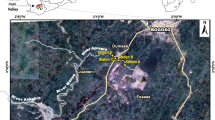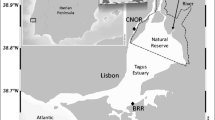Abstract
Chlor-alkali plants using mercury (Hg) cell technology are acute point sources of Hg pollution in the aquatic environment. While there have been recent efforts to reduce the use of Hg cells, some of the emitted Hg can be transformed to neurotoxic methylmercury (MeHg). Here, we aimed (i) to study the dispersion of Hg in four reservoirs located downstream of a chlor-alkali plant along the Olt River (Romania) and (ii) to track the activity of bacterial functional genes involved in Hg methylation. Total Hg (THg) concentrations in water and sediments decreased successively from the initial reservoir to downstream reservoirs. Suspended fine size particles and seston appeared to be responsible for the transport of THg into downstream reservoirs, while macrophytes reflected the local bioavailability of Hg. The concentration and proportion of MeHg were correlated with THg, but were not correlated with bacterial activity in sediments, while the abundance of hgcA transcript correlated with organic matter and Cl− concentration, indicating the importance of Hg bioavailability in sediments for Hg methylation. Our data clearly highlights the importance of considering Hg contamination as a legacy pollutant since there is a high risk of continued Hg accumulation in food webs long after Hg-cell phase out.




Similar content being viewed by others

References
Acha D, Hintelmann H, Yee J (2011) Importance of sulfate reducing bacteria in mercury methylation and demethylation in periphyton from Bolivian Amazon region. Chemosphere 82:911–916
Bae H-S, Dierberg FE, Ogram A (2014) Syntrophs dominate sequences associated with the mercury-methylating gene hgcA in the water conservation areas of the Florida Everglades. Appl Environ Microbiol 80:6517–6526
Ben-Dov E, Brenner A, Kushmaro A (2007) Quantification of sulfate-reducing bacteria in industrial wastewater, by real-time polymerase chain reaction (PCR) using dsrA and apsA genes. Microb Ecol 54:439–451
Bond DR, Mester T, Nesbo CL, Izquierdo-Lopez AV, Collart FL, Lovley DR (2005) Characterization of citrate synthase from Geobacter sulfurreducens and evidence for a family of citrate synthases similar to those of eukaryotes throughout the Geobacteraceae. Appl Environ Microbiol 71:3858–3865
Bravo AG, Loizeau J-L, Ancey L, Ungureanu VG, Dominik J (2009) Historical record of mercury contamination in sediments from the Babeni Reservoir in the Olt River, Romania. Environ Sci Pollut Res 16:66–75
Bravo AG, Loizeau JL, Bouchet S, Richard A, Rubin JF, Ungureanu VG, Amouroux D, Dominik J (2010) Mercury human exposure through fish consumption in a reservoir contaminated by a chlor-alkali plant: Babeni Reservoir (Romania). Environ Sci Pollut Res 17:1422–1432
Bravo AG, Cosio C, Amouroux D, Zopfi J, Chevalley P-A, Spangenberg JE, Ungureanu V-G, Dominik J (2014) Extremely elevated methyl mercury levels in water, sediment and organisms in a Romanian reservoir affected by release of mercury from a chlor-alkali plant. Water Res 49:391–405
Case RJ, Boucher Y, Dahllof I, Holmstrom C, Doolittle WF, Kjelleberg S (2007) Use of 16S rRNA and rpoB genes as molecular markers for microbial ecology studies. Appl Environ Microbiol 73:278–288
Compeau GC, Bartha R (1985) Sulfate-reducing bacteria : principal methylators of mercury in anoxic estuarine sediment. Appl Environ Microbiol 50:498–502
Cosio C, Fluck R, Regier N, Slaveykova VI (2014) Effects of macrophytes on the fate of mercury in aquatic systems. Environ Toxicol Chem 24:1225–1237
Dean WE (1974) Determination of carbonate and organic matter in calcareous sediments and sedimentary rocks by loss on ignition; comparison with other methods. J Sediment Res 44:242–248
el Fantroussi S, Verschuere L, Verstraete W, Top EM (1999) Effect of phenylurea herbicides on soil microbial communities estimated by analysis of 16S rRNA gene fingerprints and community-level physiological profiles. Appl Environ Microbiol 65:982–988
Fleming EJ, Mack EE, Green PG, Nelson DC (2006) Mercury methylation from unexpected sources: molybdate-inhibited freshwater sediments and an iron-reducing bacterium. Appl Environ Microbiol 72:457–464
Gilmour CC, Elias DA, Kucken AM, Brown SD, Palumbo AV, Schadt CW, Wall JD (2011) Sulfate-reducing bacterium Desulfovibrio desulfuricans ND132 as a model for understanding bacterial mercury methylation. Appl Environ Microbiol 77:3938–3951
Gilmour CC, Podar M, Bullock AL, Graham AM, Brown SD, Somenahally AC, Johs A, Hurt RA Jr, Bailey KL, Elias DA (2013) Mercury methylation by novel microorganisms from new environments. Environ Sci Technol 47:11810–11820
Goni-Urriza M, Corsellis Y, Lanceleur L, Tessier E, Gury J, Monperrus M, Guyoneaud R (2015) Relationships between bacterial energetic metabolism, mercury methylation potential, and hgcA/hgcB gene expression in Desulfovibrio dechloroacetivorans BerOc1. Environ Sci Pollut Res Int (in press)
Gray JE, Hines ME, Higueras PL, Adatto I, Lasorsa BK (2004) Mercury speciation and microbial transformations in mine wastes, stream sediments, and surface waters at the Almadén Mining District, Spain. Environ Sci Technol 38:4285–4292
Hamelin S, Amyot M, Barkay T, Wang YP, Planas D (2011) Methanogens: principal methylators of mercury in lake periphyton. Environ Sci Technol 45:7693–7700
Hsu-Kim H, Kucharzyk KH, Zhang T, Deshusses MA (2013) Mechanisms regulating mercury bioavailability for methylating microorganisms in the aquatic environment: a critical review. Environ Sci Technol 47:2441–2456
Jonsson S, Skyllberg U, Nilsson MB, Westlund P-O, Shchukarev A, Lundberg E, Bjo E (2012) Mercury methylation rates for geochemically relevant HgII species in sediments. Environ Sci Technol 21:11653–11659
Kerin EJ, Gilmour CC, Roden E, Suzuki MT, Coates JD, Mason RP (2006) Mercury methylation by dissimilatory iron-reducing bacteria. Appl Environ Microbiol 72:7919–7921
Larras F, Regier N, Planchon S, Poté J, Renaut J, Cosio C (2013) Physiological and proteomic changes suggest an important role of cell walls in the high tolerance to metals of Elodea nuttallii. J Hazard Mater 263:575–583
Liu Y-R, Yu R-Q, Zheng Y-M, He J-Z (2014) Analysis of the microbial community structure by monitoring an Hg methylation gene (hgcA) in paddy soils along an Hg gradient. Appl Environ Microbiol 80:2874–2879
Mason RP, Reinfelder JR, Morel FMM (1996) Uptake, toxicity, and trophic transfer of mercury in a coastal diatom. Environ Sci Technol 30:1835–1845
Monperrus M, Gonzalez PR, Amouroux D, Alonso JIG, Donard OFX (2008) Evaluating the potential and limitations of double-spiking species-specific isotope dilution analysis for the accurate quantification of mercury species in different environmental matrices. Anal Bioanal Chem 390:655–666
Morel FMM, Kraepiel AML, Amyot M (1998) The chemical cycle and bioaccumulation of mercury. Annu Rev Ecol Syst 29:543–566
Parks JM, Johs A, Podar M, Bridou R, Hurt RA, Smith SD, Tomanicek SJ, Qian Y, Brown SD, Brandt CC, Palumbo AV, Smith JC, Wall JD, Elias DA, Liang L (2013) The genetic basis for bacterial mercury methylation. Science 339:1332–1335
Regier N, Frey B, Converse B, Roden E, Grosse-Honebrick A, Bravo AG, Cosio C (2012) Elodea nuttallii roots effect on bacterial communities and MMHg proportion in a Hg polluted sediment. PLoS ONE 7:e45565
Regier N, Larras F, Bravo AG, Ungereanu VG, Cosio C (2013) Hg bioaccumulation in the macrophyte Elodea nuttallii in the field and in microcosm: Hg in shoots accumulated from the water might involve Cu transporters. Chemosphere 90:595–602
Ritz C, Spiess A-N (2008) qpcR: an R package for sigmoidal model selection in quantitative real-time polymerase chain reaction analysis. Bioinformatics 24:1549–1551
Rodriguez Martín-Doimeadios RC, Monperrus M, Krupp E, Amouroux D, Donard OFX (2003) Using speciated isotope dilution with GC-inductively coupled plasma MS to determine and unravel the artificial formation of monomethylmercury in certified reference sediments. Anal Chem 75:3202–3211
Schaefer JK, Yagi J, Reinfelder JR, Cardona T, Ellickson KM, Tel-Or S, Barkay T (2004) Role of the bacterial organomercury lyase (MerB) in controlling methylmercury accumulation in mercury-contaminated natural waters. Environ Sci Technol 38:4304–4311
Schaefer JK, Kronberg R-M, Morel FMM, Skyllberg U (2014) Detection of a key Hg methylation gene, hgcA, in wetland soils. Environ Microbiol Rep 6:441–447
Scheuhammer AM, Meyer MW, Sandheinrich MB, Murray MW (2007) Effects of environmental methylmercury on the health of wild birds, mammals, and fish. Ambio 36:12–18
Steinberg LM, Regan JM (2008) Phylogenetic comparison of the methanogenic communities from an acidic, oligotrophic fen and an anaerobic digester treating municipal wastewater sludge. Appl Environ Microbiol 74:6663–6671
Stewart AJ, Smith JG, Loar JM (2011) Long-term water-quality changes in east fork poplar creek, Tennessee: background, trends, and potential biological consequences. Environ Manage 47:1021–1032
Tichopad A, Dilger M, Schwarz G, Pfaffl MW (2003) Standardized determination of real-time PCR efficiency from a single reaction set-up. Nucleic Acids Res 31:e122
Tomiyasu T, Matsuyama A, Eguchi T, Fuchigami Y, Oki K, Horvat M, Rajar R, Akagi H (2006) Spatial variations of mercury in sediment of Minamata Bay, Japan. Sci Total Environ 368:283–290
Tomiyasu T, Takenaka S, Noguchi Y, Kodamatani H, Matsuyamab A, Oki K, Kono Y, Kanzaki R, Akagi H (2014) Estimation of the residual total mercury in marine sediments of Minamata Bay after a pollution prevention project. Mar Chem 159:19–24
Ullrich SM, Tanton TW, Abdrashitova SA (2001) Mercury in the aquatic environment: a review of factors affecting methylation. Crit Rev Environ Sci Technol 31:241–293
UNEP (2011) INC2 briefing paper series. Mercury in chlor-alkali plants. http://www.unep.org/chemicalsandwaste/Portals/9/Mercury/Documents/INC2/ZMWG6_Chlor_20alkali_FS0111_04.pdf. Accessed 09.06.2015.
UNEP (2013a) Global estimate of global mercury cell chlorine capacity, world chlorine report to UNEP on chlor-alkali partnership data 2011 and 2012. http://www.unep.org/chemicalsandwaste/Metals/GlobalMercuryPartnership/Chlor-alkaliSector/Reports/tabid/4495/Default.aspx. Accessed 09.06.2015.
UNEP (2013b Global mercury assessment: sources, emissions, releases and environmental transport. http://www.unep.org/PDF/PressReleases/GlobalMercuryAssessment2013.pdf. Accessed 09.06.2015.
USEPA (2001) Method 1630: methyl mercury in water by distillation, aqueous ethlylation, purge and trap, and CVAFS. US Environmental Protection Agency, Office of Water, draft
Watras CJ, Morrison KA, Host JS, Bloom NS (1995) Concentration of mercury species in relationship to other site-specific factors in the surface waters of northern Wisconsin lakes. Limnol Oceanogr 40:556–565
Yu RQ, Flanders JR, Mack EE, Turner R, Mirza MB, Barkay T (2012) Contribution of coexisting sulfate and iron reducing bacteria to methylmercury production in freshwater river sediments. Environ Sci Technol 46:2684–2691
Yu RQ, Reinfelder JR, Hines ME, Barkay T (2013) Mercury methylation by the methanogen Methanospirillum hungatei. Appl Environ Microbiol 79:6325–6330
Acknowledgments
This work is part of the Romanian–Swiss Research Program with the project number IZERZO-142228, funded by the Swiss National Science Foundation (SNF) and Romanian Executive Agency for Higher Education, Research, Development and Innovation Funding (UEFISCDI). The work was also partially supported by the SNF (project 205321_138254) and Swedish Research Council (project 623-2011-7191). We thank the National Administration Apele Romane Olt for permission to work in their laboratory, GeoEcoMar for providing the boat, Aline Freiburghaus and Dany Dumitru Grosu for support and help during the sampling, Dolly Kothawala for English editing and improvement.
Author information
Authors and Affiliations
Corresponding author
Additional information
Responsible editor: Philippe Garrigues
Electronic supplementary material
Below is the link to the electronic supplementary material.
Table S1
Sequences and characteristics of primers used to analyze the microbial activity by RT-qPCR. (DOCX 29 kb)
Table S2
Pearson correlation coefficients (α = 0.05) between water surface sediments, transcripts’ abundance, and biota sampled in several reservoirs along the Olt River (Romania) during field campaign in September 2014. Coefficients higher than 0.75 are shown in bold. (XLSX 18 kb)
Table S3
Pearson correlation coefficient (α = 0.05) between sediments and transcripts’ abundance in sediments sampled in several reservoirs along the Olt River (Romania) during field campaign in September 2014. Coefficients higher than 0.75 are shown in bold. (DOCX 19 kb)
Rights and permissions
About this article
Cite this article
Bravo, A.G., Loizeau, JL., Dranguet, P. et al. Persistent Hg contamination and occurrence of Hg-methylating transcript (hgcA) downstream of a chlor-alkali plant in the Olt River (Romania). Environ Sci Pollut Res 23, 10529–10541 (2016). https://doi.org/10.1007/s11356-015-5906-4
Received:
Accepted:
Published:
Issue Date:
DOI: https://doi.org/10.1007/s11356-015-5906-4



